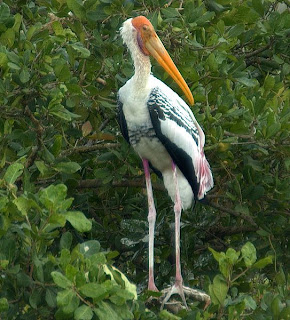 |
| Mycteria leucocephala |
The coloration on the Painted Stork also becomes more dull when it is outside of the breeding season. Plumage plays an important role in finding a mate, as does dancing! When seeking out a partner, the male Storks perform elaborate bows. If a female likes the male's bow, they will do a bit of a dance. One paired up the couple will go on to build a platform-like nest out of sticks and vegetation. These birds are highly gregarious during the breeding season, and sometimes nests end up almost on top of one another. Both parents incubate the eggs and feed the hatched chicks using regurgitated fish. Delicious!
As adults, the Painted Storks use their large bills to forage. They wade very slowly in shallow water (typically less and 1ft deep), and probe around with their bill partially open. If they hit something, they snap their bill shut. Fish make up most of the diet, though they do also eat Amphibians and Crustaceans.
Painted Storks are listed as Near Threatened because of habitat loss, hunting, and pollution. The birds do live within some protected areas, but the population continues to be on a downward trend.
IUCN Status : Near Threatened
Location : South Asia
Size : Height up to 40in (1m)
Classification : Phylum : Chordata -- Class : Aves -- Order : Ciconiiformes
Family : Ciconiidae -- Genus : Mycteria -- Species : M. leucocephala
Family : Ciconiidae -- Genus : Mycteria -- Species : M. leucocephala
Comments
Post a Comment